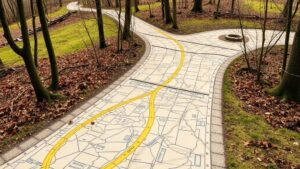Exploring Railroad Expansion Plans for Forgotten Trackside Artifacts
Exploring Railroad Expansion Plans for Forgotten Trackside Artifacts
The expansion of railroads across the United States has been a significant aspect of the nation’s economic and cultural development since the mid-19th century. In light of recent revitalization efforts, it is compelling to explore the intersection of modern railroad expansion plans and the preservation of historical artifacts that lie forgotten along the tracks. This article aims to investigate how such expansion plans can incorporate strategies for documenting, preserving, and potentially repurposing these artifacts.
Historical Context of Railroad Expansion
The expansion of railroads in the United States began in earnest with the completion of the First Transcontinental Railroad in 1869, connecting the east and west coasts. Since then, railroads have driven industrial growth, facilitated trade, and fostered the movement of people, ultimately shaping American society. By the early 20th century, over 254,000 miles of track crisscrossed the country, with numerous structures such as depots, water towers, and loading docks established along these routes.
The Importance of Trackside Artifacts
Trackside artifacts, which include historical train stations, wooden telegraph poles, and vintage signal towers, represent a tangible connection to the past. Preservationists argue that these structures contribute to local heritage and identity. For example, the restoration of the historic Union Station in Kansas City, Missouri, exemplifies how revitalization efforts can elevate community pride and tourism. According to the National Trust for Historic Preservation, heritage tourism is a $126 billion industry in the United States, underscoring the economic benefits of preserving historical sites.
Current Trends in Railroad Expansion
In recent years, various railroad companies have announced plans to expand tracks and services, focusing on passenger rail, freight movement, and sustainability. Amtrak, for example, has proposed initiatives to enhance regional rail connections, particularly in the Northeast Corridor and the Midwest. Similarly, freight railroads emphasize infrastructure development to accommodate the rising demand for goods transport.
Challenges in Preserving Historical Artifacts
- Urban Development: Job creation and economic growth often take precedence over heritage preservation.
- Funding Limitations: Financial resources for preserving historic sites are frequently constrained, hindering extensive restoration efforts.
- Public Awareness: Many communities lack knowledge about the historical significance of artifacts, leading to neglect or unintentional destruction.
Integrating Preservation into Expansion Plans
An amalgam of preservation and modern development strategies is essential to ensure that historical artifacts do not become casualties of progress. Key strategies may include:
- Historical Surveys: Conducting thorough surveys of potential expansion areas can identify significant historical sites that warrant protection.
- Community Engagement: Involving local stakeholders in decision-making processes fosters a sense of ownership and encourages preservation efforts.
- Adaptive Reuse: This practice involves repurposing old structures for contemporary use. For example, the High Line in New York City transformed an abandoned rail line into a vibrant public park.
Case Studies of Successful Integration
Examining cities where preservation and expansion have successfully coexisted can provide tangible insights. In San Francisco, the integration of the T-Third Street light rail line with historic neighborhoods was achieved by carefully preserving landmark buildings while enhancing public transport accessibility. This initiative not only improved mobility but also revitalized the community, merging historical significance with modern utility.
Conclusion
The coexistence of railroad expansion and the preservation of trackside artifacts presents both challenges and opportunities. By recognizing the historical value of forgotten artifacts and taking intentional steps toward their integration into modern expansion plans, municipalities and railroad companies can honor the past while fostering future growth. This balanced approach not only safeguards historical integrity but also enriches local communities economically and culturally.
As policymakers consider future railroad expansion endeavors, proactive measures in preservation can create a dual legacy of progress and remembrance, demonstrating that history and innovation can indeed travel the same track.
Actionable Takeaways
- Conduct comprehensive historical surveys prior to expansion projects.
- Engage local communities in discussions about preservation and its importance.
- Explore adaptive reuse opportunities for trackside artifacts to enhance usage and appreciation.


